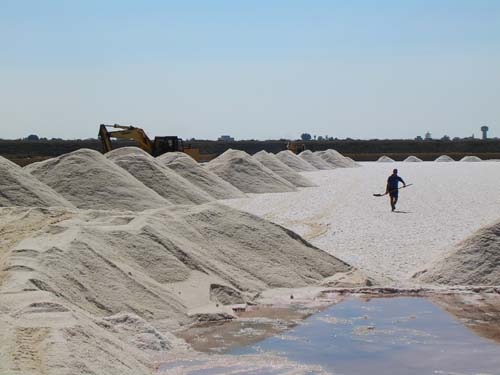Sicilians along the island's smooth western shore, blessed with saline water and hot windy summers, found themselves sitting on an almost priceless resource. They refined the technique of raking salt out of evaporated seawater, transforming the coast into a vast salt factory dotted with ponds, sluices, and nearly priceless white mounds.
Two thousand years later, salt costs a dollar a can in every supermarket in the world, and Sicily's biggest export for the past half-century has been its people. Modernity has created deep contradictions here: Tourists flock to extraordinary Greek ruins and the terraced four-star hotels of the east coast. There's a ski resort on volcanic, 11,000-foot Mount Etna. Behind that facade, the island remains a network of farms and poor villages struggling to lift itself from its corrupt feudal past.
But I had also heard that on the remote west coast there were still wide , shallow pools of seawater, and still a handful of people who spent Sicily's excruciating summer months raking evaporated slush into mounds of white crystals. It sounded so pointless, so labor-intensive, so Italian. Of course, I had to see it.
We were going to Sicily in any event. My wife studies ancient art, and we had mapped out a two-week trip around the island to see the remnants of Greek and Roman rule. The salt would require a modest little detour to the coastal city of Trapani, the unofficial capital of the salt industry.
It was March , well before the tourist season. To the east, resort hotels were just starting to unfurl their awnings. In the mountainous heart of the island, stiff winds were kicking up squalls of snow. Airport posters always make Sicily look like the Costa Brava, a playland of golden vineyards and beach umbrellas, but not this time of year. I stuffed my bathing suit into the bottom of my suitcase and bought a pair of thick felt pants.
We rented a white Fiat with a trunk that barely closed over our bags and headed west, away from the capital Palermo and the big resorts. I had been warned about the terrors of driving in Sicily, but we floated almost calmly across its broad ribbon highways, cutting through green hills speckled with the island's ubiquitous half-built concrete apartments. We laughed about our car's tiny engine and its tiny name -- "Punto," the Dot -- until we started noticing other Fiat Puntos passing us at 120 miles an hour, straight into oncoming traffic. Far sooner than we expected, maybe an hour from the airport, we found ourselves approaching the salt coast. continue>>>





